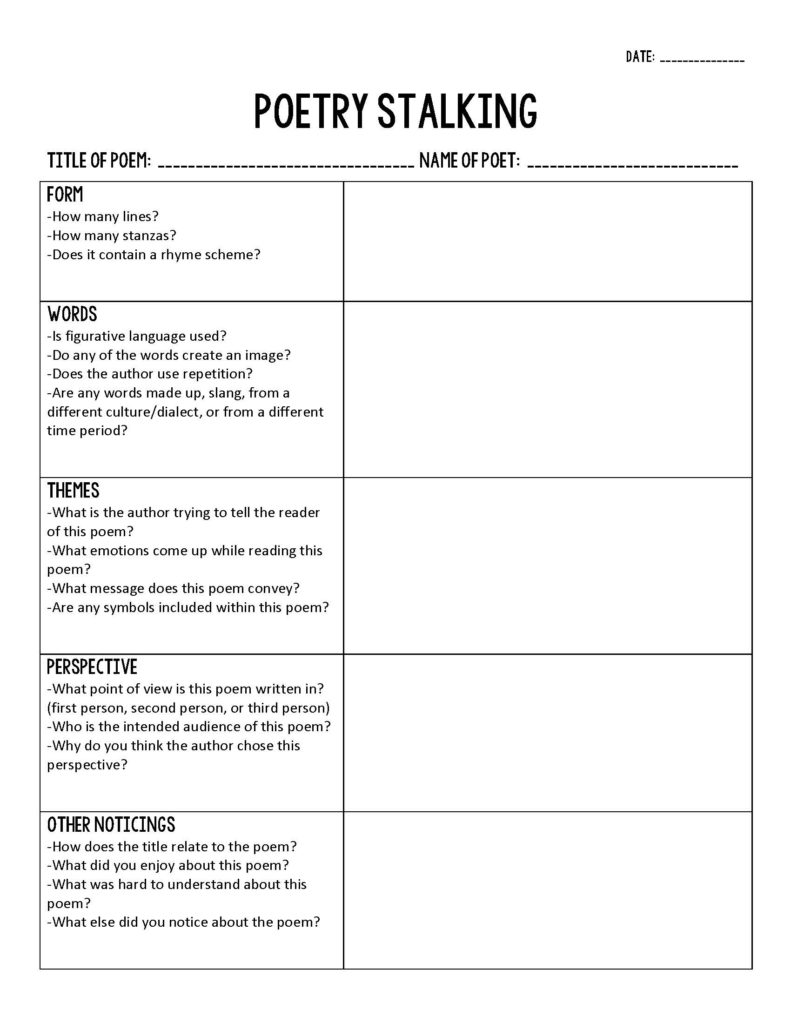I believe in the power of poetry, which gives me reasons to look ahead and identify a glint of light.
Mahmoud Darwish
Poetry Workshop is one of my very favorite things to do with students. I’ve laid out every step and resource that I use to implement Poetry Workshop and keep it going in this resource. In this blog post, however, I’m going to dig deeper into one piece of Poetry Workshop that I call “Poetry Stalking” which is a loving nod to one of teachers’ most loved resources I’ve created, “Sentence Stalking.” The premise of sentence stalking is to notice and note different aspects of a mentor sentence. Poetry Stalking is the same thing, just with a poem. I’m going to break down the process of Poetry Stalking below and give resources for you to implement in your virtual classroom during our season of distance learning we are currently experiencing. April is poetry month, and my heart hurts a little extra when I think about all the experiences my students and I are missing out on sharing together. Poetry Stalking lends itself well to distance learning and is still a great way to create a shared poetry experience with your students.
How to Set Up Poetry Stalking Virtually:
Step One: Select a poem. Finding a great poem to share with middle school students can sometimes be a little tricky. If you want a little extra help with selecting one students will love, check out recommendations by Brynn from The Literacy Maven. You can post the link to the poem you select right in your virtual classroom.
Step Two: Ask students to independently read the poem several times and think about what they notice while they read.
Step Three: Ask students to complete the “Poetry Stalking” activity. There are several different aspects students will consider: form, words, themes, perspective, and other noticings. Looking at the poem from multiple lenses allows students to think about and analyze the poem in ways they may not have considered.

You can access the “Poetry Stalking” Google Doc sheet here. Simply “make a copy” and use it in your Google Classroom or other virtual classroom platform.
For students without Internet access, you can print a hard copy from this PDF document to send home.
Please note that students shouldn’t be expected to answer every question listed. The questions are there to help students generate ideas for what to notice about the selected poem. Additionally, not every question will be applicable to every poem.
Step Four: Discussion and collaboration are huge parts of making Poetry Stalking a meaningful activity for students. In this time of distance learning, here are some ideas for creating discussion and collaboration around Poetry Stalking.
- Have students share their noticings using a digital speaking tool such as Flipgrid or Screencastify.
- If you are using Google Hangouts or some other equivalent to virtually meet with your students, make this an agenda item to discuss as a whole group.
- Use Padlet or have students comment on a post in your virtual classroom to share out their favorite noticing from the sentence stalking of the day.
Poetry is powerful and can be therapeutic and hope-giving. We need all of these things in our world right now and always. I hope this blog post gives you an idea for how you can continue to create a meaningful shared poetry experience with your students.
-Kasey





